
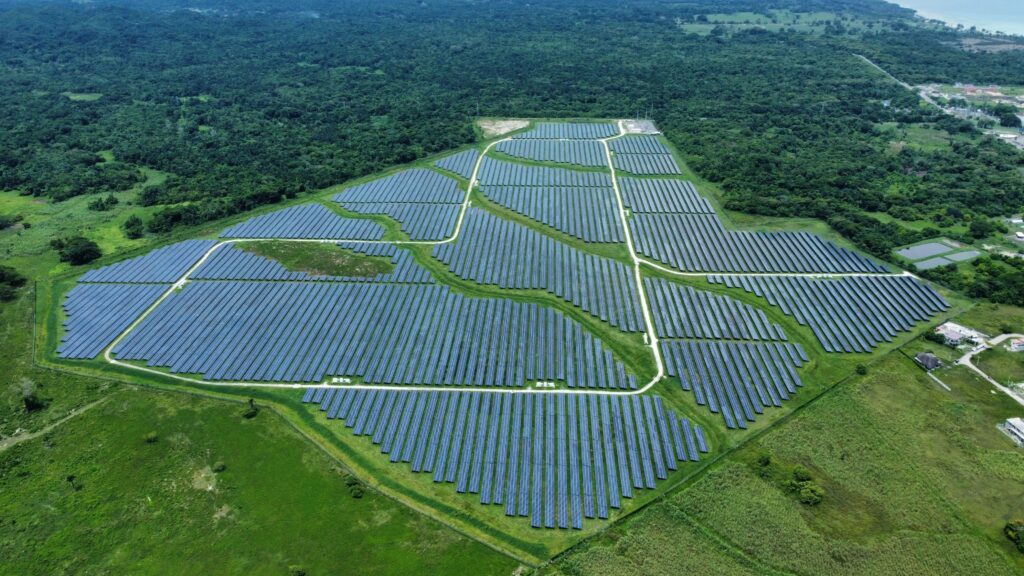
That was one of the questions on the minds of participants at the 15th Caribbean Renewable Energy Forum (CREF), held April 26-28 in Miami, Florida. The event brought together more than 450 high-level government officials, utility regulators, business executives, bankers, representatives of international institutions, and others to explore developments on the renewable energy front.
Despite some bright spots in the region, much of the progress in recent years has been merely incremental, several speakers noted. Bruce Levy, President and CEO of BMR Energy, said many utility-scale projects stalled during the COVID-19 pandemic, as governments had to devote time and resources to other priorities.
“Energy wasn’t anywhere on their program,” he said.
And now, as countries try to get their economies back on their feet, they don’t seem to be implementing the type of “green-focused recovery” that would advance the energy transition and create jobs, said James Fletcher, Chairman of the Board of the Caribbean Centre for Renewable Energy and Energy Efficiency (CCREEE).
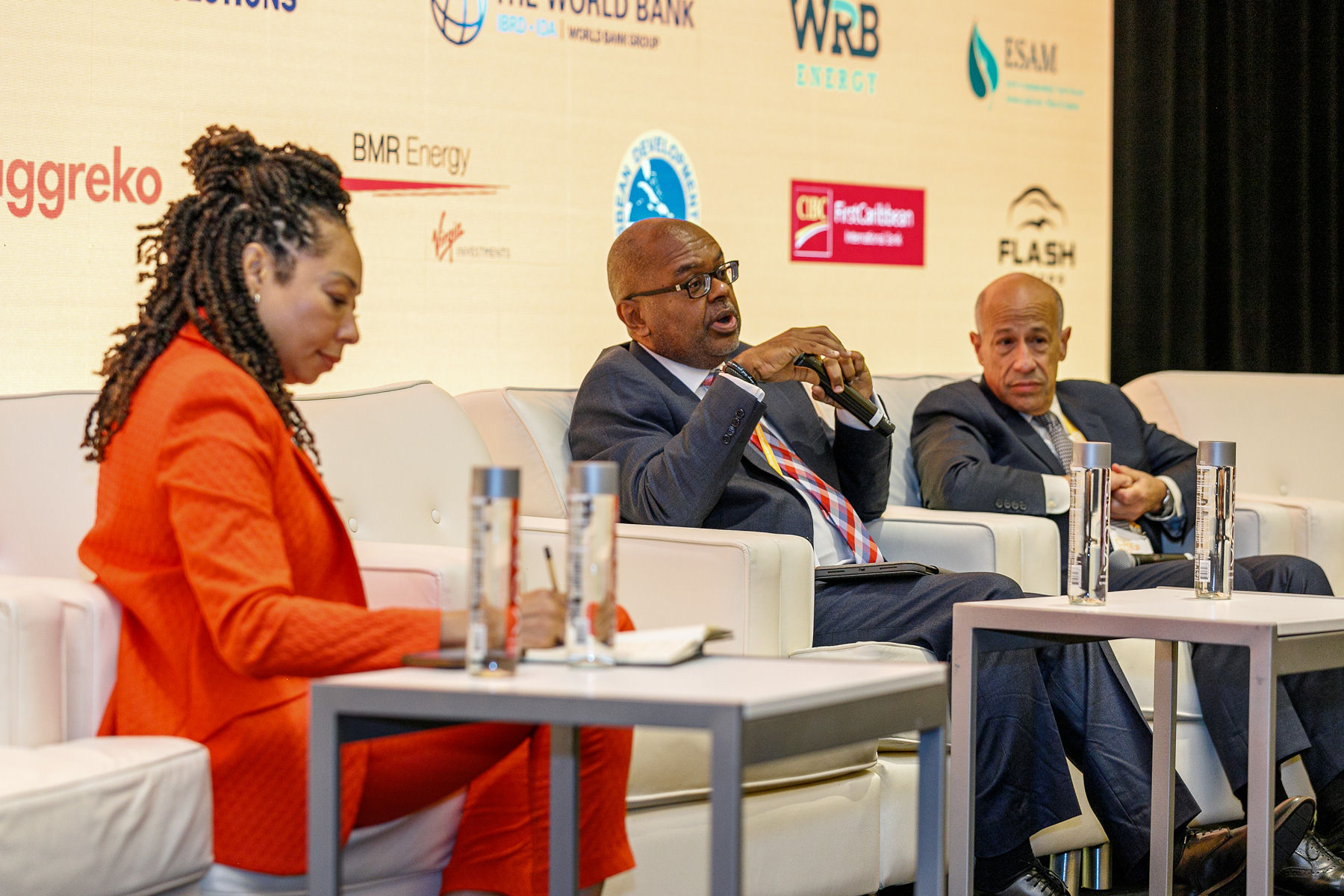
Racquel Moses of the Caribbean Climate Smart Accelerator moderates a discussion at CREF with James Fletcher (center) and Bruce Levy.
Every government should have a high-level champion of renewable energy, Fletcher said—a “pit bull” who will shake things up and pick up the pace.
One of the main factors in favor of renewable energy is cost. The levelized cost of energy—in other words, the current value of the total cost of building and operating a power plant over its assumed lifetime—has dropped dramatically for several green technologies.
From 2010 to 2021, the global cost of utility-scale solar photovoltaic (PV) energy fell by 88%, while onshore wind saw a price decline of 56% and offshore wind 50%, according to Daniel Best, who heads the Project Department at the Caribbean Development Bank (CDB).
Still, the region remains heavily dependent on fossil fuels, and changing that will take a massive amount of investment. The Caribbean region needs about US$1.25 billion per year to make the energy transition a reality; however, in the past year, the volume of investment was only around $50 million, Best said.
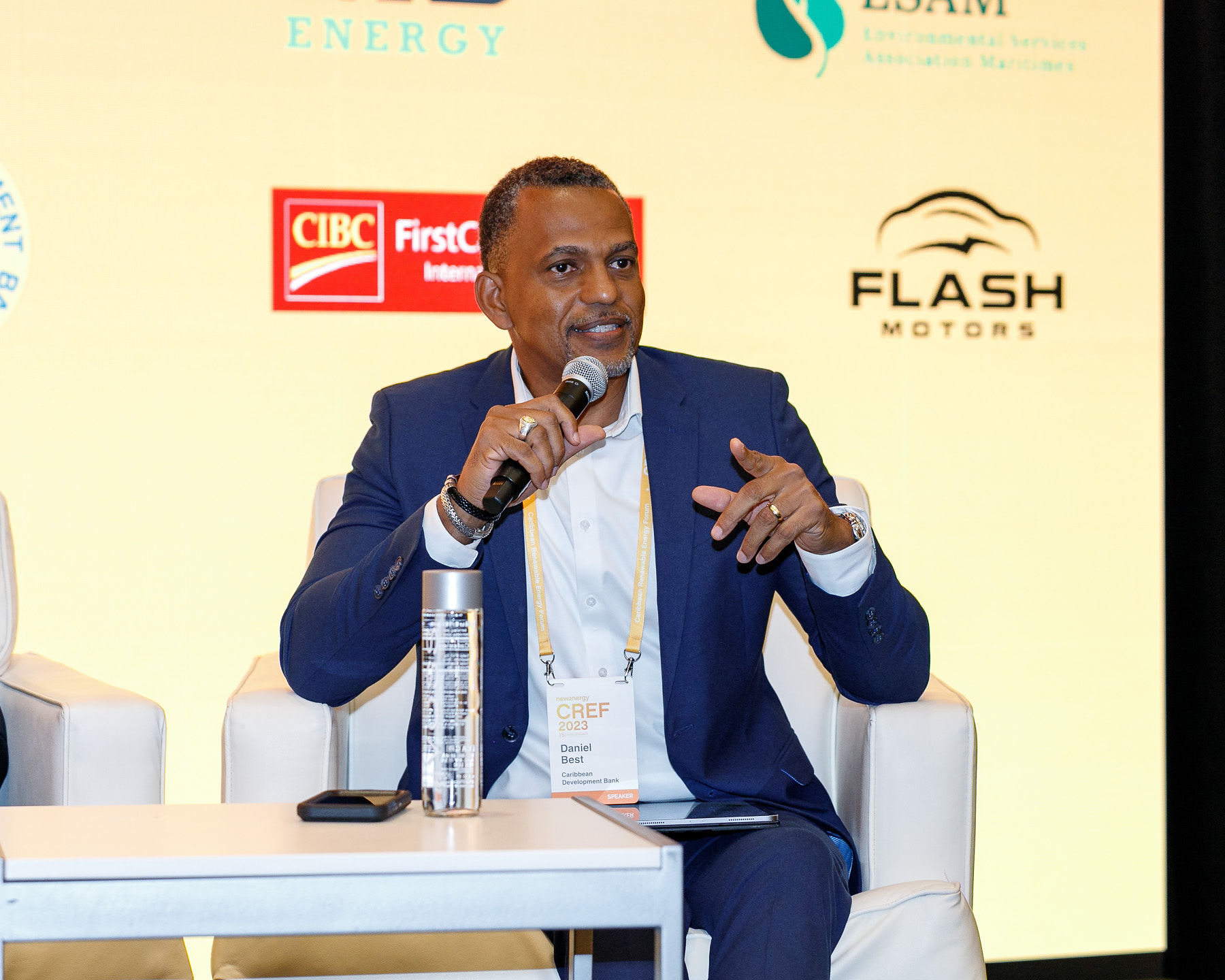
The Caribbean region is seeing only a fraction of the investment in renewable energy needed for the energy transition, according to Daniel Best of the Caribbean Development Bank.
“You see the gap that exists between what we need to do to drive the energy transition and what is actually happening in the region,” he said during a panel discussion on finance.
In a different session, Levy stressed that renewable energy makes economic sense, even considering the technical issues that need to be addressed, such as those related to transmission and integration of renewables into the grid.
“Renewable energy is always cheaper than oil and gas,” he said. Even if petroleum prices drop temporarily, he said, the world’s producers will never let them stay low. And in the meantime, renewable energy technologies continue to evolve and become more efficient.
Levy cautioned that small economies in the Caribbean will not necessarily see the same rock-bottom prices for electricity generation as have sometimes been achieved in the United States, where the electricity sector, the incentive structure, and the economies of scale are completely different. But, he said, they can do better than they have done with fossil fuels.
“I don’t think it’s possible to make a bad decision on renewable energy, so long as it’s cheaper than what you’re currently paying,” he said.
Many jurisdictions in the Caribbean have set ambitious goals on green energy and climate action, in some cases aiming to produce 100% of their electricity from renewable sources by 2030. Yet the latest version of the Caribbean Renewable Islands Index, which tracks progress on a range of indicators, shows that overall, the region seems to be falling short.
“We’re going to have to run hard to reach the targets that we’ve set for ourselves,” said David Ehrhardt, Chief Executive of Castalia Advisors, which has compiled the index for a decade.
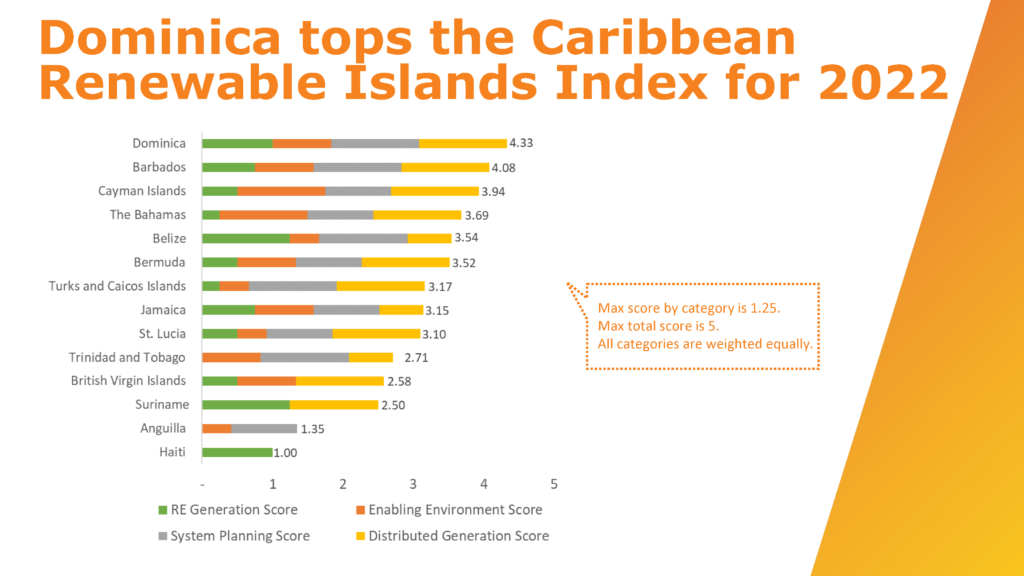
Slide source: Castalia Advisors.
Performance varied widely among the 14 sovereign nations and other jurisdictions that responded to the 2022 Castalia survey. Dominica had the highest overall score, followed by Barbados, the Cayman Islands, the Bahamas, and Belize.
In presenting the results at the conference, Ehrhardt reviewed these top performers’ scores in four categories: renewable energy generation (here, Belize and Dominica did best); enabling environment (Bahamas, Cayman Islands); system planning (Dominica, Barbados, Belize); and distributed generation (Dominica, Barbados, Belize, Bahamas).
To close the gaps between the current status and the targets, Ehrhardt stressed, countries must ensure that they have a regulatory framework in place that will support the integration of renewable energy. At a “bare minimum,” he said, they need an Integrated Resource and Resilience Plan; a procurement and financing mechanism; access to site, resource, and environmental permits; a distributed generation framework; cost-recovery tariffs; and creditworthy utilities.
The need for a sound regulatory environment to promote investment was a recurring theme throughout the conference.
“From the regulators’ perspective, we have to create an enabling environment for renewables to thrive and to be successful,” said Cheryl Lewis of Jamaica’s Office of Utilities Regulation. “Investors need certainty and stability.”
It’s not only about adopting the right laws and regulations, she said, but also about having the know-how to interpret those in a way that is fair and equitable. “Human skills and resources are also necessary,” she said.
The U.S.-Caribbean Partnership to Address the Climate Crisis 2030 (PACC 2030), launched at last year’s Summit of the Americas, is working with several countries in the region to close some of those gaps, according to Barbara Feinstein, Deputy Assistant Secretary for Caribbean Affairs and Haiti in the State Department’s Bureau of Western Hemisphere Affairs.
She said several U.S. government agencies are providing technical assistance to help strengthen regulatory frameworks and the capacity to evaluate projects and issue tenders. “These initiatives aim to create the right conditions for the private sector and local government to partner on renewable energy projects,” she said.
For Jerry Butler, the Founding Chairman of the Caribbean Renewable Energy Forum (CREF), the goal of weaning the region off fossil fuels is nothing short of a crusade.
“We all recognize the dangers of continued reliance on fossil fuels: greater carbon emissions, exposure to volatile prices, unproductive and expensive energy subsidies, and vulnerability to geopolitical shocks like Russia’s invasion of Ukraine,” she told the conference.
The United States is also supporting the Caribbean region in its efforts to expand access to finance, she said, such as by pursuing reforms at the Inter-American Development Bank (IDB) and providing a recent $1 billion contribution to the Green Climate Fund. She noted that the U.S. Agency for International Development (USAID) is also helping Barbados set up the Blue-Green Investment Corporation to finance climate change mitigation and adaptation as well as clean energy projects.
Financing for climate and energy projects continues to be a challenge for the region, and several speakers called for lending institutions to simplify access. Kerryne James, Minister of Climate Resilience, the Environment and Renewable Energy of Grenada, mentioned the need for grant funding to cover such efforts as environmental assessments and geothermal studies.
One solution for funding this type of early-stage work is what is called a contingent recovery grant. The Caribbean Development Bank, with support from the Inter-American Development Bank, is using this type of instrument to finance geothermal development on the island of Nevis (part of the nation of Saint Kitts and Nevis). As Daniel Best of the CDB explained, the initial funding takes the form of a grant; however, if the resource is proven and a plant eventually built, the grant converts to a loan.

Sulphur Springs, in Saint Lucia, is one of many geothermal fields located in the volcanic islands of the Eastern Caribbean.
Mark Brantley, Premier of Nevis, said he sees access to clean, cheap energy not only as a public good but as a basic human right, and financing is necessary to make that a reality.
“We can talk till the cows come home, but if money is not available to implement, then it’s just talk,” he said.
Collaboration is also critical, Brantley said. “We need to be able to learn from each other’s mistakes and successes.”
That point was also made by Quincia Gumbs Marie, Minister of Sustainability, Innovation and the Environment for the government of Anguilla, a British overseas territory.
“We need to work together to solve our shared problems,” she said, adding that collaboration is the only way for the Caribbean region to make real progress. “We’re small fish in a big pond,” she said.
For Jerry Butler, the Founding Chairman of the Caribbean Renewable Energy Forum (CREF), the goal of weaning the region off fossil fuels is nothing short of a crusade.
Fifteen years ago, the Bahamian economist teamed up with Matthew Perks of New Energy Events to start an annual conference that would focus the region on the prospects for renewable energy.
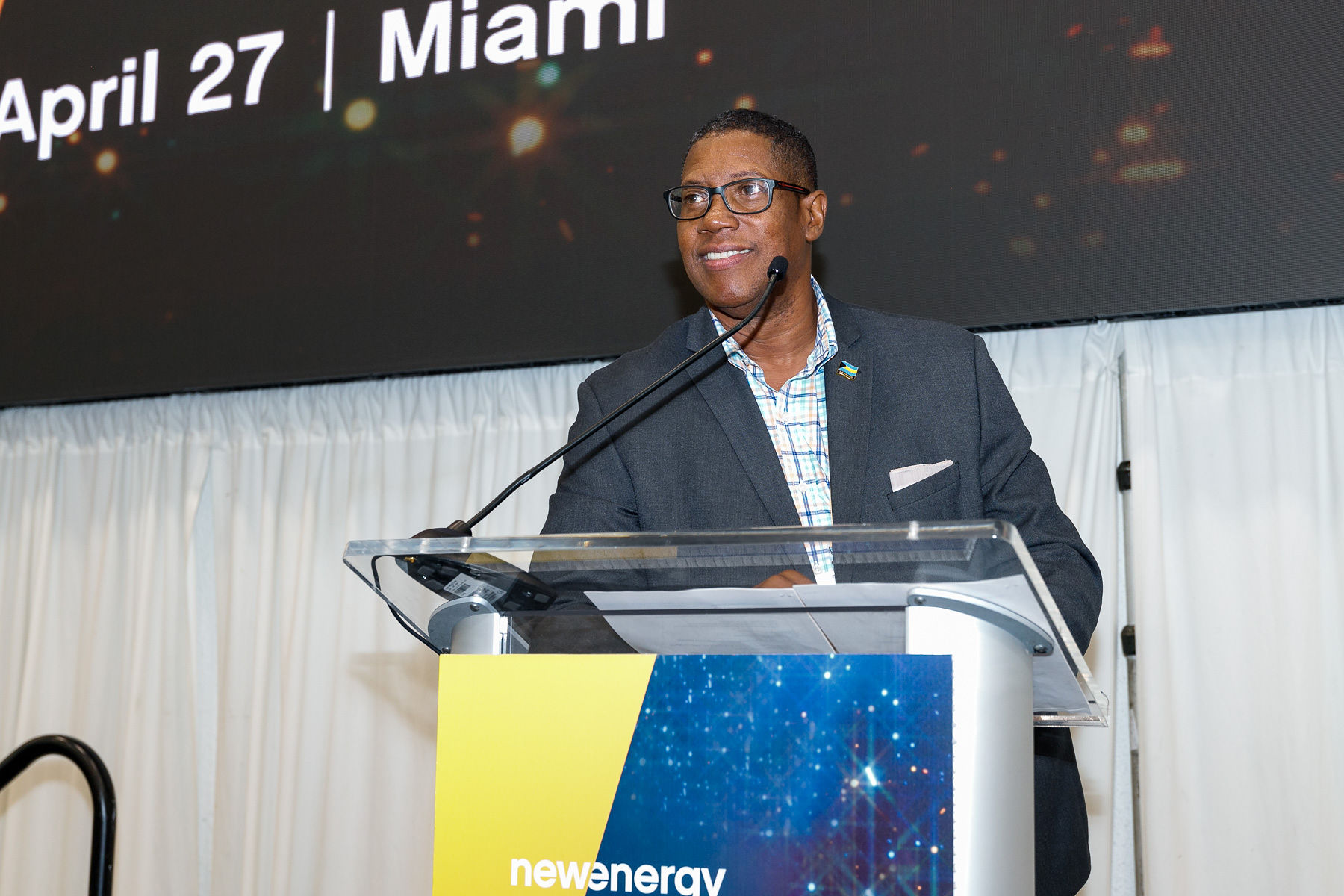
CREF Founding Chairman Jerry Butler says the annual event has provided a “spark” for renewable energy projects across the region.
The impetus for the idea, he said in an interview, was the high level of debt facing many Caribbean countries. Two major factors were the region’s constant need to rebuild after ever-stronger hurricanes and its heavy dependence on imported fuel with no control over prices.
As Butler sees it, the solution is to build a more sustainable future where the fuel is renewable and Caribbean-made. “That, to me, would be the end of my crusade,” he said.
The process of getting there has its ups and downs, and in the past few years, the pandemic and severe hurricanes have caused some setbacks, he said. But, he added, it’s important to remember that progress is being made.
Over the years, Butler said, CREF has provided a “spark” for many renewable energy projects that have ended up being built in the region. More broadly, he said, it has helped to raise awareness and make the case for renewable energy as a sustainable, bankable alternative to fossil fuels.
Another sign of progress, he said, has been the growing participation of women in CREF and the creation of an entity called Women in Renewable Energy (WIRE). In the past few years, he noted, the Caribbean has been graduating more female than male engineers and technicians at the university level.
“If you want a crusade where there’s a battle, you take men with you,” Butler said. “But if you want a crusade where there’s a conversion, you take the women.”
 View Map
View Map